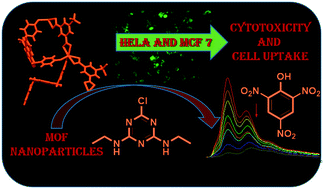Synthesis of fluorescent MOFs: live-cell imaging and sensing of a herbicide†
Abstract
Various zinc and cadmium containing metal–organic frameworks using the semi-rigid 1,1′-(anthracene-9,10-diylbis(methylene))bis(pyridin-1-ium-4-olate) ligand (L = AHP) and various sulfonic acid analogs [1,5-naphthalenedisulfonic acid (1,5-NDS), 3-sulfobenzoic acid (3-SBA), 4-sulfobenzoic acid (4-SBA), 5-sulfosalicylic acid (SSA), 5-sulfoisophthalic acid (SIA) and 2,6-naphthalenedisulfonic acid (2,6-NDS)] have been synthesized by a hydrothermal method. They have been characterized by powder X-ray diffraction thermogravimetric analysis and single crystal X-ray diffraction methods. The X-ray studies showed that MOF2, 4, and 8 have two dimensional architectures whereas 1, 3, 5, 6 and 7 have three-dimensional structures. The topological analysis demonstrated that all the zinc-containing MOFs have a hexagonal (hcb) net topology with the point symbol of the framework being {63} whereas cadmium-containing MOF4 has an sql net topology with the point symbol of the framework being {44·62} and MOF5 has a hcb net topology with the point symbol of the framework being {63}. Since all synthesized MOFs have fluorescence properties, they have been used as imaging agents for MCF7 cells. The cytotoxic experiments show that more than 92% cells survive at the dose 100 μg ml−1. The cell imaging results show that the MOF particles were found in the cytoplasm rather than in the nucleus and these can be used further as a conjugate with any known anti-cancer drugs in cellular distribution. The emission properties of these MOFs have been utilized for the detection of a herbicide (simazine) as well as nitroaromatic compounds. The quenching constant for PA (picric acid) in MOF7 was found to be 5.01 × 104 M−1, which may be due to the interaction of picric acid and co-ligands present in MOF7.

- This article is part of the themed collection: Editor’s Collection: Bio-applications of MOFs


 Please wait while we load your content...
Please wait while we load your content...